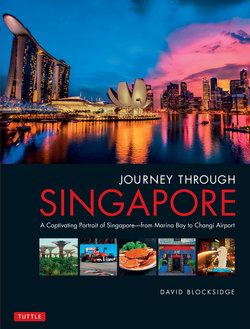Читать книгу Journey Through Singapore - David Blocksidge - Страница 8
ОглавлениеSingapore’s Rich Colonial Heritage
Singapore has preserved many iconic buildings from its colonial past.
The colonial history of Singapore began in 1819 when Raffles landed. Many early buildings were designed by the Irish architect George Coleman, who consulted with Raffles on the Town Plan of 1822–3. Several of his buildings remain, including the charming Armenian Church. Another great architect of the colonial period was the Englishman Alfred John Bidwell, whose work included the original main wing of the Raffles Hotel, the Goodwood Hotel, Stamford House, Singapore Cricket Club and Victoria Theatre. Between them, these two men created the finest colonial architecture in the region. The Padang, or town square, is the centre for several fine buildings, including the Cricket Club, Supreme Court, City Hall, old Parliament House (now the newly renovated and reopened National Gallery) and Victoria Theatre. Many historic buildings were lost, however, in the race for economic prosperity after independence.
A bust of Sir Thomas Stamford Raffles, the founder of Singapore. Many reminders of him can be found around the island, visible in images and in the use of his name.
Raffles Hotel was previously a boarding house for Raffles Institution, an old and prestigious secondary school. It is also the birthplace of a famous local cocktail, the Singapore Sling.
The National Gallery’s special exhibition, ‘After the Rain’, is a collection of works by artist Chua Ek Kay.
Raffles Hotel, with its gleaming marble colonnades, is one of the finest examples of colonial architecture. Pictured here in the hotel’s lobby.
The Asian Civilisations Museum, established in 1997, faces the Singapore River and houses exhibitions featuring the material history of Singapore and ancestral homes from around Asia.
Previously the Convent of the Holy Infant Jesus, now known as CHIJMES, the buildings around the chapel have been transformed into restaurants and shops. The church is used for weddings and other private events.
Whole neighbourhoods were destroyed, although critics should recall that many of the buildings torn down were cramped and waterlogged. Conservation efforts began in 1970 with the passing of the Preservation of Monuments Act, followed in 1973 by the Urban Redevelopment Act. While Bugis Street (which was moved 300 metres!) and Little India have been criticized, preservation work at Boat Quay, the former St Joseph’s Institution (now the Singapore Art Museum), Empress Place and elsewhere has been highly praised.
The ‘Living World’ by Taiwanese sculptor Ju Ming is a permanent exhibit outside the National Museum of Singapore.
The Old Hill Street Police Station was built in 1934 in the Neoclassical style. It now houses several government ministries, including the Ministry of Communications and Information and the Ministry of Culture, Community and Youth.
A 6-metre cast-iron fountain is the focal point of the Palm Garden in front of the Raffles Hotel.
Students cluster around the white polymarble statue of Sir Stamford Raffles at the Raffles Landing Site. The original statue, nicknamed ‘Iron Man’, was cast in bronze and is now in front of the Victoria Concert Hall.
The Singapore Art Museum, rehoused in the restored nineteenth-century St Joseph’s Institution, opened its doors in 1996.
The Sikh doorman at the Raffles Hotel is one of the most photographed people in Singapore.
One of the windows of the Tan Teng Niah Residence, an eight-room multicoloured villa that mixes Peranakan and European influences in its design.
